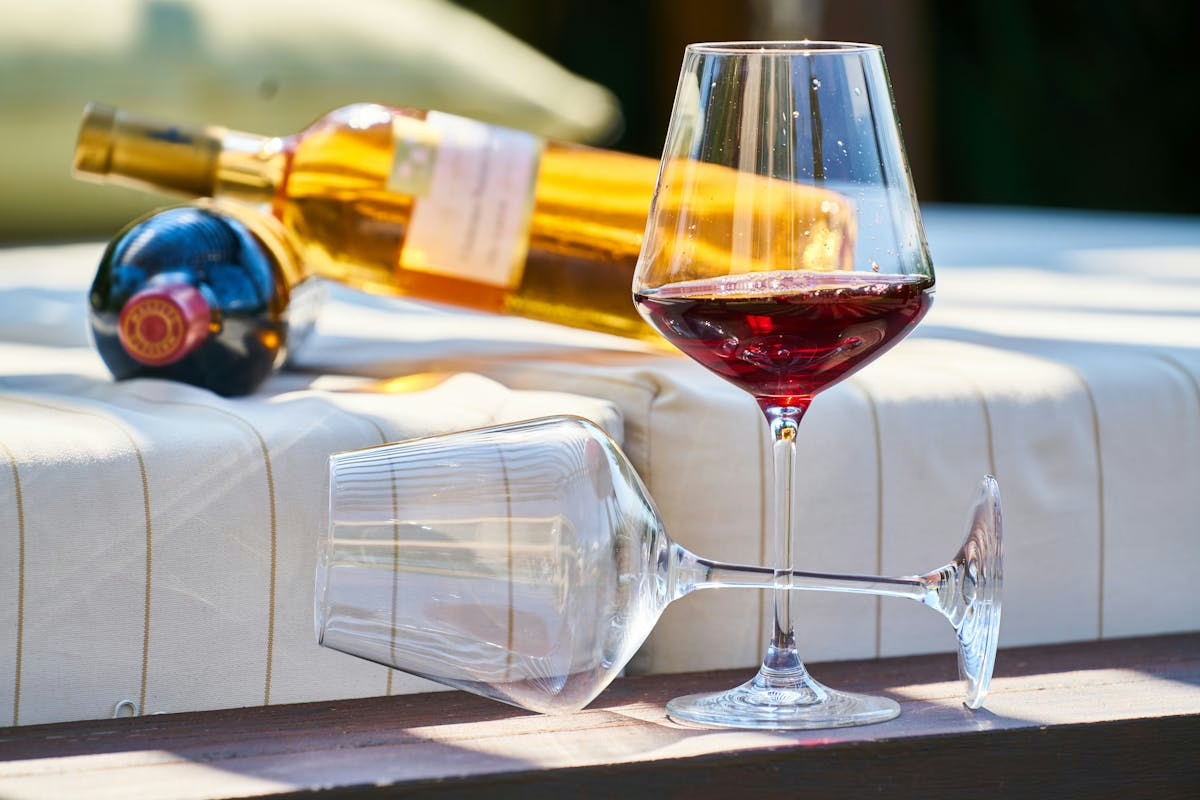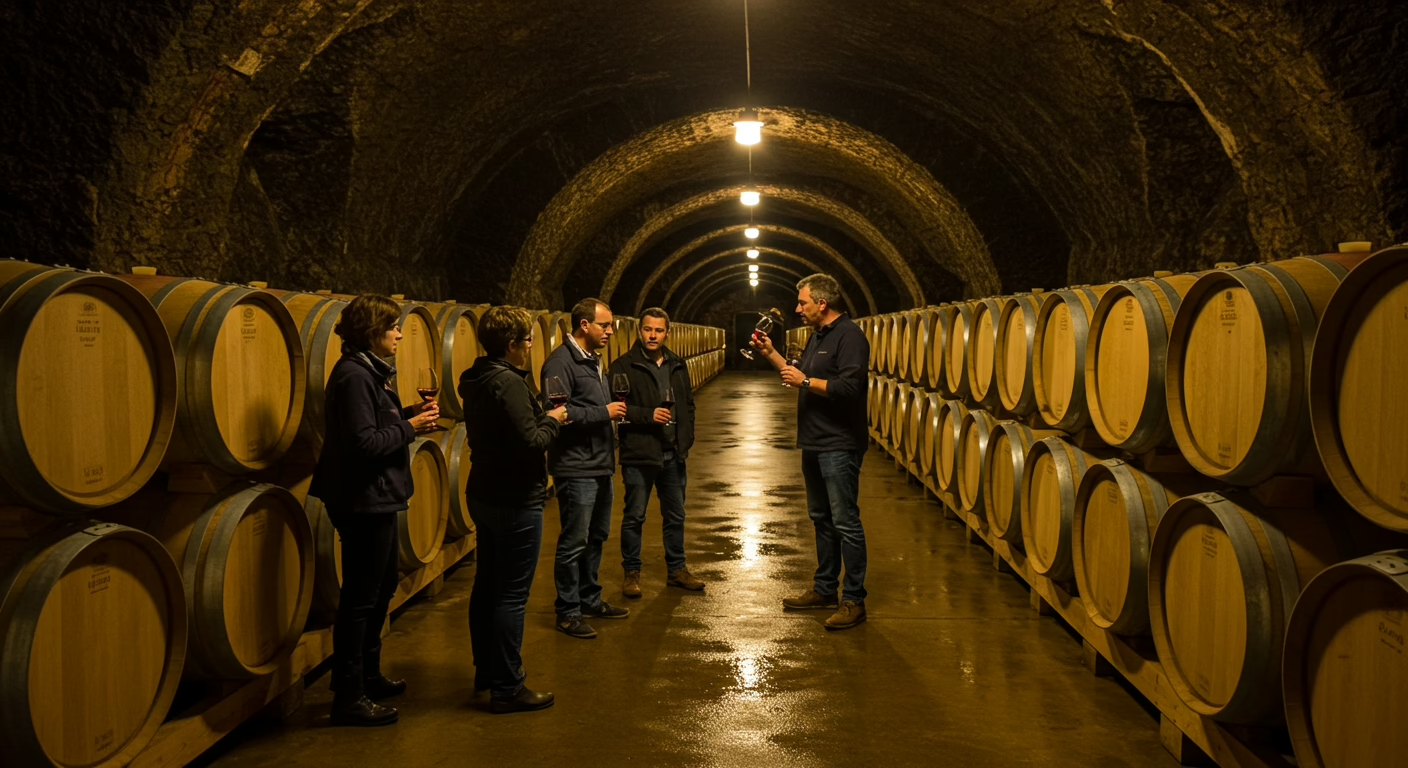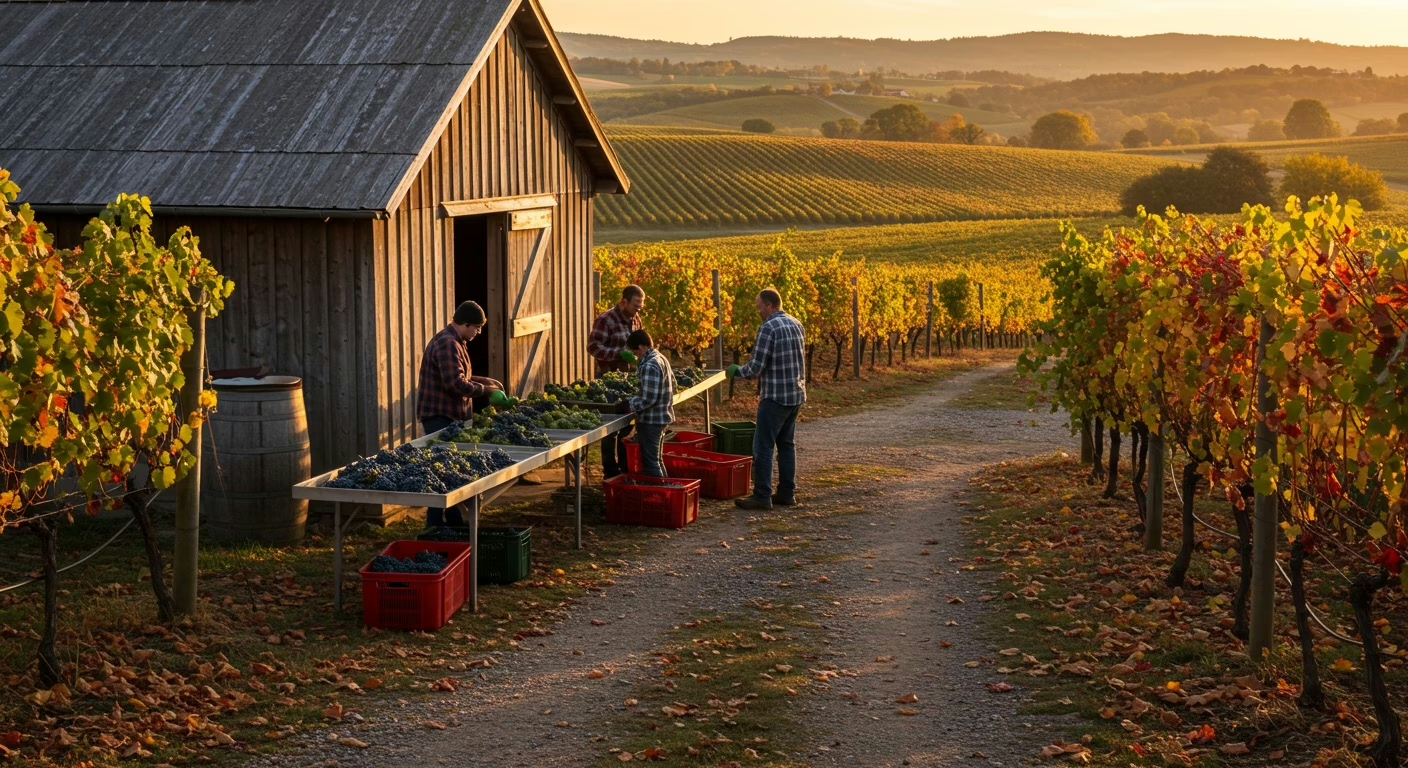
White Wine vs Red Wine: Key Differences in Taste, Pairings, and Production
Whether you’re planning an intimate wine tasting experience in Napa Valley or simply deciding what to serve with dinner, understanding the differences between white and red wines can significantly enhance your appreciation of these beloved beverages.
At Designated Drivers Napa Sonoma, we help guests experience the full spectrum of wine culture safely and comfortably with our private driver services for tours in Napa. From custom itineraries to insider access, we ensure you get the most out of your California wine tours.
The contrast between white and red wines goes far beyond color. These two styles differ fundamentally in how they’re produced, how they taste, what they pair well with, and how they age. As wine culture continues to flourish across California’s renowned wine regions, more enthusiasts are seeking to deepen their knowledge of these nuanced differences.
This guide explores the essential contrasts between white and red wines, helping you navigate your next wine tasting experience in Napa, CA, with confidence and sophistication. From vineyard to glass, each wine’s journey offers a unique sensory experience that has captivated wine lovers for centuries.
How Are White and Red Wines Made?
The most fundamental difference between white and red wines begins in the production process. White wines are typically produced using only the juice of grapes, with the skins, seeds, and stems removed before fermentation. This process, known as pressing, happens immediately after harvesting to prevent color transfer from the skins.
In contrast, red wines derive their distinctive color, tannins, and many flavor compounds through a process called maceration, where the juice ferments in contact with the grape skins and seeds. This difference in production creates the foundation for all other distinctions between these wine categories.
The length of maceration significantly impacts a red wine’s character. Longer contact results in deeper color and more pronounced tannins. Some premium red wines may macerate for weeks to develop complex structures and aging potential.
White wine production generally focuses on preserving the delicate, fresh fruit characteristics of the grapes. Fermentation typically occurs at cooler temperatures (45-60°F) compared to red wines (68-86°F), which helps maintain the wine’s aromatic compounds. Modern technology has revolutionized this process, with temperature-controlled stainless steel tanks allowing winemakers precise control over fermentation conditions.
When visiting Napa Valley wineries, you’ll often get the opportunity to see these production differences firsthand, with many estates offering behind-the-scenes tours that demonstrate these contrasting approaches to winemaking. Want to explore both red and white winemaking styles up close? Let our local drivers guide you through curated Napa Valley wineries.
What Does the Wine Color Tell You?
The color differences between white and red wines extend far beyond the simple binary that their names suggest. White wines display a remarkable spectrum ranging from pale straw and lemon-green to deep gold and amber. These variations often indicate the wine’s age, grape variety, and production methods. For instance, oak-aged Chardonnays typically show deeper golden hues compared to stainless steel-fermented varieties.
Red wines showcase an even more diverse color palette, from light ruby and garnet to deep purple and nearly opaque black. Young red wines often display vibrant purple edges, while aged examples develop brick-red or brownish tints as they mature. The color intensity in red wines correlates strongly with the thickness of grape skins and the length of maceration during production.
Interestingly, a wine’s color can provide several clues about its character before you even taste it. A deep, inky Syrah likely promises bold, intense flavors, while a pale Pinot Noir suggests delicacy and subtlety. During a professional wine tasting experience, sommeliers often begin by examining a wine’s color against a white background to assess its age, concentration, and potential quality.
According to a 2023 study by the International Wine Institute, consumers can correctly identify approximately 65% of a wine’s characteristics simply by analyzing its color properly, a testament to how much information this visual element provides to experienced tasters.
Flavor Profiles: Comparing Taste and Texture
The flavor differences between white and red wines create distinctly different sensory experiences. White wines typically showcase bright acidity with flavor profiles centered around citrus, tree fruits (apple, pear), tropical fruits, and floral notes. Their structural elements focus on acidity and sometimes minerality rather than tannins, creating wines that often feel crisp and refreshing on the palate.
Red wines, conversely, present a more complex structural framework built around tannins, which create that distinctive drying sensation in your mouth. Their flavor profiles commonly include red and black fruits (cherry, blackberry, plum), along with spice, earth, tobacco, and chocolate notes. The mouthfeel of red wines tends to be fuller and more substantial compared to whites, with descriptors like “velvety,” “silky,” or “robust” frequently used.
Temperature significantly impacts how we perceive these flavors. White wines served too cold (below 45°F) will have suppressed aromatics, while reds served too warm (above 65°F) can taste alcoholic and flabby. The general guideline that says serve whites chilled (45-55°F) and reds slightly below room temperature (55-65°F) exists to optimize the sensory experience of each style.
During California wine tours, experienced guides often demonstrate how temperature affects wine perception by allowing guests to taste the same wine at different temperatures, revealing how proper serving temperature can transform the tasting experience.
Food Pairing Principles: What Works Best with Each?
Perhaps nowhere are the differences between white and red wines more practical than in food pairing applications. The structural components of each wine type, acidity in whites and tannins in reds, create different interactions with food.
White wines, with their pronounced acidity and lighter body, typically pair wonderfully with:
- Seafood and fish dishes
- Light chicken preparations
- Fresh salads and vegetable dishes
- Soft, young cheeses
- Spicy Asian cuisines, where the cooling effect of a chilled white wine can balance the heat
Red wines, with their tannin structure and more robust flavors, complement:
- Red meats and game
- Mushroom-based dishes
- Tomato-based sauces and stews
- Hard, aged cheeses
- Chocolate desserts (particularly with fruitier red wines)
The classic pairing wisdom, “white with fish, red with meat”, has merit but oversimplifies the nuanced potential of wine pairing. The sauce, preparation method, and accompanying ingredients often matter more than the main protein. Many Napa Valley wineries now offer specialized food and wine pairing experiences that demonstrate these principles through carefully crafted combinations.
A 2024 Cornell University study found that successful food and wine pairings typically match the weight and intensity of both elements, delicate dishes with lighter wines, bold flavors with more robust wines, regardless of color. This “weight matching” principle often proves more reliable than simply following traditional color-based pairing rules.
Health Differences and Misconceptions
The health implications of wine consumption represent another significant difference between red and white varieties. Red wines contain substantially higher levels of polyphenols, particularly resveratrol, which has been associated with potential cardiovascular benefits when consumed in moderation. These compounds derive primarily from grape skins during the maceration process, a step largely absent in white wine production.
A landmark 2022 study published in the Journal of Nutritional Biochemistry found that moderate red wine consumption (1-2 glasses daily) was associated with a 15-20% reduction in cardiovascular disease risk compared to abstention. White wine showed more modest benefits, with approximately a 5-10% risk reduction. However, researchers emphasized that these benefits disappear with excessive consumption of either type.
Red wines also contain significantly higher levels of antioxidants than whites, with dry red wines like Cabernet Sauvignon and Syrah ranking highest. These antioxidants help combat free radicals in the body, potentially reducing oxidative stress.
White wines, while lower in these compounds, typically contain fewer calories (approximately 120 calories per 5-ounce glass compared to 125-130 for reds) and lower histamine levels, making them sometimes better tolerated by those with certain sensitivities.
Health experts universally caution that while moderate wine consumption may offer certain benefits, these should never be the primary motivation for drinking. During intimate Napa Valley wine tours for couples, responsible tasting practices are always encouraged, with quality appreciation emphasized over quantity.
How Long Wines Age: White vs. Red
The aging potential of wine represents another fundamental difference between white and red varieties. While both can improve with age, red wines generally possess greater longevity due to their higher tannin content, which acts as a natural preservative. Tannins gradually polymerize over time, softening the wine’s astringency while allowing complex tertiary flavors to develop.
Most white wines are produced for consumption within 1-3 years of release, with their primary appeal centered around fresh fruit characteristics and vibrant acidity. Notable exceptions include high-acid whites like Riesling, traditional white Burgundies, and fortified varieties like Sauternes, which can evolve beautifully for decades.
Premium red wines from regions like Napa Valley often reach their peak drinking window 10-20 years after vintage, with some exceptional examples continuing to improve for 50+ years. During this maturation period, red wines undergo remarkable transformations. Fruit flavors evolve toward dried fruit characters, tannins integrate more completely, and complex tertiary notes of leather, tobacco, and forest floor emerge.
Wine collectors generally invest more heavily in age-worthy reds, with certain vintages appreciating significantly in value. According to a 2023 Sotheby’s wine market report, investment-grade red wines have historically appreciated 8-12% annually compared to 3-5% for comparable white wines.
For wine enthusiasts exploring California wine tours, vertical tastings (sampling multiple vintages of the same wine) offer fascinating glimpses into this aging process. Curious about aged wines? Ask your private designated driver at Napa to include vertical tastings on your next tour.
Terroir and Wine Expression: How Place Influences Wine Type
The concept of terroir, how specific growing environments influence wine character, manifests differently in white and red varieties. White wine grapes often express minerality and soil influences more transparently, with varieties like Chablis famously reflecting their limestone-rich soils through distinctive flinty notes.
Red wine grapes typically channel terroir through structural elements like tannin development and fruit ripeness patterns. Regions with wide diurnal temperature swings (warm days, cool nights) often produce red wines with optimal phenolic ripeness while preserving natural acidity, exemplified by Napa Valley’s exceptional Cabernet Sauvignon.
Climate plays a decisive role in determining which wine types excel in specific regions. Cooler climates generally favor white wine production, with grapes retaining their crucial acidity while developing complex aromatics. Warmer regions typically excel with reds, allowing complete phenolic ripening essential for balanced tannin development.
When planning a private driver for tours in Napa, consider exploring sub-appellations that showcase these terroir differences. The volcanic soils of Howell Mountain produce dramatically different Cabernets than the alluvial soils of Rutherford, while the cooler Carneros region excels with Chardonnay and Pinot Noir, vivid demonstrations of how terroir shapes wine expression differently across red and white varieties.
From volcanic soils to cool-climate vineyards, experience the full range of Napa terroirs with a private driver who knows the terrain.
Wine FAQs
What temperature should I serve white and red wines?
White wines generally show best when served between 45-55°F (7-13°C), with lighter whites like Sauvignon Blanc at the cooler end and fuller-bodied whites like oaked Chardonnay at the warmer end.
Red wines typically express their aromatics optimally between 55-65°F (13-18°C), with lighter reds like Pinot Noir served cooler and fuller-bodied reds like Cabernet Sauvignon at the warmer end. Serving temperatures significantly impact flavor perception. Too cold suppresses aromatics while too warm emphasizes alcohol and diminishes freshness.
Can white wines be made from red grapes?
Yes, white wines can be produced from red grapes. The classic example is Champagne, where clear juice is pressed from Pinot Noir and Pinot Meunier (both red varieties) without skin contact. This technique, called “blanc de noirs” (white from black), is also used for still white wines in some regions.
Since grape pigments reside primarily in the skins rather than the pulp, minimal skin contact during processing allows winemakers to create white wines from red grape varieties.
Which wine has more calories, red or white?
White wines typically contain slightly fewer calories than red wines, though the difference is marginal. A standard 5-ounce (150ml) glass of dry white wine averages about 120 calories, while the same volume of dry red wine averages 125-130 calories.
Sweet wines of either color contain substantially more calories due to their residual sugar content. The calorie difference between reds and whites stems primarily from alcohol content—reds often have slightly higher ABV levels, and alcohol contains 7 calories per gram compared to carbohydrates’ 4 calories per gram.
Is it true that red wine causes worse hangovers than white wine?
Many people report more severe hangovers from red wine, and there is some scientific basis for this experience. Red wines contain significantly higher levels of congeners (byproducts of fermentation) and histamines compared to white wines.
These compounds can trigger inflammatory responses and contribute to headaches in sensitive individuals. Additionally, red wines typically contain more tannins, which may interfere with serotonin production and contribute to headache symptoms. However, individual responses vary greatly, and alcohol quantity remains the primary determinant of hangover severity regardless of wine type.
How long do white and red wines last after opening?
White wines typically remain drinkable for 1-3 days after opening when stored properly (recorked and refrigerated). Lighter, higher-acid whites often maintain their quality longer than fuller-bodied examples. Red wines generally last 3-5 days after opening, with higher tannin varieties often showing better on the second day, as exposure to oxygen can soften their structure initially.
Vacuum sealers and inert gas preservation systems can extend these timeframes significantly. For both wine types, quality gradually diminishes after opening as oxidation processes continue.
Savoring the Differences Between White and Red
The differences between white and red wines extend far beyond their colors, encompassing distinct production methods, flavor profiles, structural elements, and aging trajectories. These variations create complementary experiences that enhance our culinary traditions and social gatherings in different ways.
Whether you prefer the crisp refreshment of a chilled Sauvignon Blanc or the complex depth of an aged Cabernet Sauvignon, understanding these fundamental differences enhances appreciation and enjoyment. For the ultimate exploration of these contrasts, consider experiencing both styles in their natural habitat through a guided wine tasting experience in Napa.
The region’s diverse microclimates and innovative winemaking approaches offer perfect examples of both wine categories at their finest. By deepening your understanding of how and why these wines differ, you’ll transform ordinary sipping into meaningful appreciation of one of humanity’s oldest and most cherished culinary arts.
Contact Designated Drivers Napa Sonoma for Your Wine Country Experience
Designated Drivers Napa Sonoma specializes in creating memorable, safe, and educational wine country experiences throughout California’s premier wine regions. Our professional drivers and wine guides provide knowledgeable transportation services that allow you to fully immerse yourself in the wine tasting experience without worrying about transportation.
With intimate knowledge of boutique wineries, hidden gems, and iconic estates, we customize each tour to match your preferences while ensuring your safety. Whether you’re planning a romantic getaway, milestone celebration, or educational wine adventure, our team handles the logistics while you create the memories.
Book your private driver for Napa and Sonoma today and discover the remarkable differences between white and red wines with expert guidance and zero transportation concerns.

